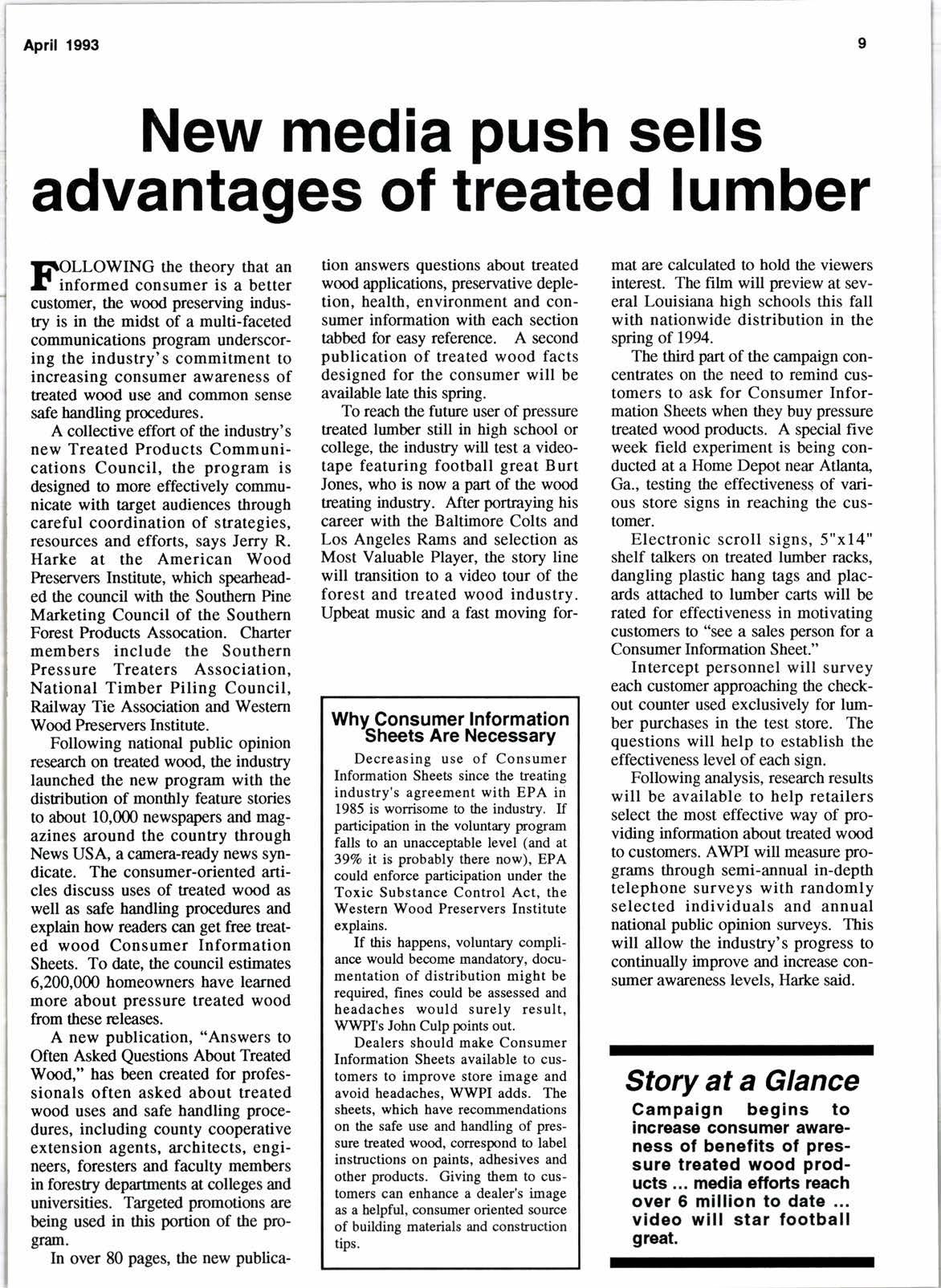
3 minute read
New media push sells advantages of treated lumber
ETOLLOWING the theory that an I' informed consumer is a better customer, the wood preserving industry is in the midst of a multi-faceted communications progrzrm underscoring the industry's commitment to increasing consumer awareness of treated wood use and common sense safe handling procedures.
A collective effort of the indusEy's new Treated Products Communications Council, the program is designed to more effectively communicate with target audiences through careful coordination of strategies, resources and efforts, says Jerry R. Harke at the American Wood Presenrers Institute, which spearheaded the council with the Southern Pine Marketing Council of the Southern Forest Products Assocation. Charter members include the Southern Pressure Treaters Association, National Timber Piling Council, Railway Tie Association and Western Wood Preservers Institute.
Following national public opinion research on treated wood, the industry launched the new program with the distribution of monthly feature stories to about 10,000 newspapers and magazines around the country through News USA, a carnera-ready news syndicate. The consumer-oriented articles discuss uses of treated wood as well as safe handling procedures and explain how readers can get free treated wood Consumer Information Sheets. To date, the council estimates 6,200,000 homeowners have learned more about pressure treated wood from these releases.
A new publication, "Answers to Often Asked Questions About Treated Wood," has been created for professionals often asked about treated wood uses and safe handling procedures, including county cooperative extension agents, architects, engineers, foresters and faculty members in forestry departnents at colleges and universities. Targeted promotions are being used in this portion of the program.
In over 80 pages, the new publica-
[ion answers questions abut treated wood applications, preservative depletion, health, environment and consumer information with each section tabbed for easy reference. A second publication of treated wood facts designed for the consumer will be available late this spring.
To reach the future user of pressure treated lumber still in high school or college, the indusfy will test a videotape featuring football great Burt Jones, who is now a part of the wood Eeating industry. After portraying his career with the Baltimore Colts and Los Angeles Rams and selection as Most Valuable Player, the story line will transition to a video tour of the forest and treated wood industry. Upbeat music and a fast moving for-
Whv Consumer Information Sheets Are Necessary
Decreasing use of Consumer Information Sbeets since the treating industry's agreement with EPA in 1985 is worrisome o the industy. If participation in the voluntary progam falls to an unacceptable level (and at 39Vo it is probably there now), EPA could enforce participation under the Toxic Substance Control Act. the Western Wood Preservers Institute explains.
If this happens, voluntary compliance would become mandatory, documentation of distribution might be required, fines could be assessed and headaches would surely result, WWPI's John Culp points out.
Dealers should make Consumer Information Sheets available to customers to improve store image and avoid headaches, WWPI adds. The sheets, wbich bave recommendations on tbe safe use and handling of pressure treated wood, correspond to label instructions on paints, adhesives and other products. Giving them to customers can enhance a dealer's image as a helpful, consumer oriented source of building materials and construction tips.
mat are calculated to hold the viewers interest. The film will preview at several Louisiana high schools this fall with nationwide distribution in the spring of 1994.
The third part of the campaign concentrates on the need to remind customers to ask for Consumer Information Sheets when they buy pressure treated wood products. A special five week field experiment is being conducted at a Home Depot near Atlanta Ga., testing the effectivenes$ of various store signs in reaching the customer.
Electronic scroll signs, 5"x14" shelf talkers on treated lumber racks, dangling plastic hang tags and placards attached to lumber carts will be rated for effectiveness in motivating customers to "see a sales person for a Consumer Infornation Sheet."
Intercept personnel will survey each customer approaching the checkout cormter used exclusively for lumber purchases in the test store. The questions will help to establish the effectiveness level of each sign.
Following analysis, research results will be available to help retailers select the most effective way of providing infonnation about Eeated wood to customers. AWPI will measure programs through semi-annual in-depth telephone surveys with randomly selected individuals and annual national public opinion surveys. This will allow the industry's progress to continually improve and increase consumer awareness levels. Harke said.










